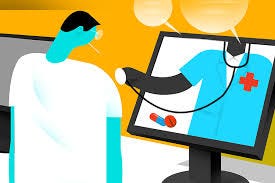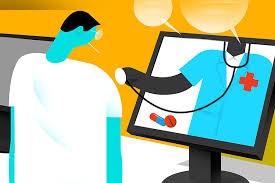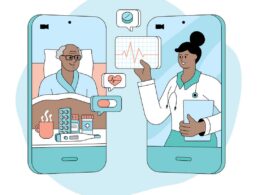Journal of Family Medicine and Primary Care
Vinoth G. Chellaiyan,1 A. Y. Nirupama,1 and Neha Taneja2
2019 Jun
forbesindia
Abstract
Telemedicine is considered to be the remote diagnosis and treatment of patients by means of telecommunications technology, thereby providing substantial healthcare to low income regions.
Earliest published record of telemedicine is in the first half if the 20 th century when ECG was transmitted over telephone lines.
From then to today, telemedicine has come a long way in terms of both healthcare delivery and technology.
A major role in this was played by NASA and ISRO.
The setting up of the National Telemedicine Taskforce by the Health Ministry of India, in 2005, paved way for the success of various projects like the ICMR-AROGYASREE, NeHA and VRCs.
Telemedicine also helps family physicians by giving them easy access to speciality doctors and helping them in close monitoring of patients.
Different types of telemedicine services like store and forward, real-time and remote or self-monitoring provides various educational, healthcare delivery and management, disease screening and disaster management services all over the globe.
Even though telemedicine cannot be a solution to all the problems, it can surely help decrease the burden of the healthcare system to a large extent.

Introduction
According to American Telemedicine Association (ATA), “Telemedicine is the natural evolution of healthcare in the digital world”.[ 1]
World Health Organization (WHO) has defined telemedicine as, “the delivery of healthcare services, where distance is a critical factor, by all healthcare professionals using information and communication technologies for the exchange of valid information for diagnosis, treatment and prevention of disease and injuries, research and evaluation, and for the continuing education of healthcare providers, all in the interests of advancing the health of individuals and their communities.”[ 2]
The word “telemedicine” literally translates to ‘healing at a distance’. It often is used as the umbrella term to encompass health care delivery in addition to other activities such as education, research, health surveillance, and public health promotion.[ 3]
Historical perspective
The allure of telemedicine is in its ability to communicate medical data over a distance.
Earliest published record of telemedicine was in the first half of the 20 thcentury when ECG was transmitted over telephone lines.[ 2]
Inventions like electrical telegraph and telephone played a vital role in kick starting the modern telemedicine as we know it.[ 4]
Telephone was able to reach a much wider population in a shorter time, as dialing ‘911’ or ‘101’ granted faster access to emergency medical care.
The April 1924 issue of Radio News magazine brought with it a new dream for future public health.
The cover showed a patient with a TV and microphone to communicate with a doctor at the other end; it was truly only a dream then because televisions had not yet come into vogue.[ 5]
The first known record of real-time (live) video consultation occurred in 1959 when the doctors at University of Nebraska used interactive telemedicine to transmit neurological examinations.[ 6]
Telemedicine found its role in disaster management when NASA first used telemedicine services during the 1985 Mexico City earthquake, and in 1988, during the Soviet Armenia earthquake, where the estimated casualties were more than 50,000.[ 7]
With the disruption of all other modes of communication, satellite technology used in telemedicine proved to be quintessential in breaking technological barriers and made a mark in history.
Telemedicine found its role in disaster management when NASA first used telemedicine services during the 1985 Mexico City earthquake, and in 1988, during the Soviet Armenia earthquake, where the estimated casualties were more than 50,000
The establishment of a commercial space center named MITAC (Medical Informatics and Technology Applications Consortium) at Yale University[ 7] in the year 1997 by NASA paved way for the current trend of private participation in public health management using telemedicine.

Modern telemedicine
Over the past several decades, as the use of wireless broadband technology has become more advanced and cell phone and internet use has become nearly ubiquitous.[ 8]
Patient education with images and videos, transfer of medical images like X-rays and scans, and real-time audio and video consultations became a reality.[ 4]
Improvement in internet infrastructure such as bandwidth communication speeds, information storage databases, web service backups, standard formats for data transmission, encryption, password protection, HIPAA (Health Insurance Portability and Accountability Act of 1996) guidelines,[ 9] digitalizing information and establishment of EMRs (electronic medical records) made e-health and telemedicine stress-free and cost effective.[ 4]
The modern day telemedicine uses existing computing devices belonging to the patient or physician and inexpensive, self-owned equipment like smartphone cameras, wearable biosensors, etc., for gathering clinical data which made it easier to use without special training.[ 4]
The recent telemedicine practices reduce travel expenses, saves time, reduces medical costs, provides easier access for the common man to specialist doctors without disrupting their daily responsibilities.
It also makes the life of healthcare providers easy by decreasing the load of missed appointments and cancellations, increasing revenue and patient load and improving follow up and health outcomes.[ 10]
Stepping into the 21 st century, various national/international organizations like the American Telemedicine Association, Washington DC, have been set up — which are solely dedicated to provision of telemedicine services.[ 1]

Telemedicine in India
India is a large nation with a population of more than 121 crores[ 11] of sundry people.
Due to this fact, the equitable distribution of healthcare services has proven to be a major goal in public health management time and again.
Adding to this is the recent trend of concentration of healthcare facilities to the cities and towns (including 75% of the population of doctors), away from rural India, where 68.84% of the national population live.[ 11]
Adding to this is the recent trend of concentration of healthcare facilities to the cities and towns (including 75% of the population of doctors), away from rural India, where 68.84% of the national population live.
ISRO (Indian Space Research Organization) made a modest beginning in telemedicine in India with a Telemedicine Pilot Project in 2001, linking Chennai’s Apollo Hospital with the Apollo Rural Hospital at Aragonda village in the Chittoor district of Andhra Pradesh.[ 12]
Initiatives taken by ISRO, Department of Information Technology (DIT), Ministry of External Affairs, Ministry of Health and Family Welfare and the state governments played a vital role in the development of telemedicine services in India.
In an attempt to coalesce the available public health data and provide easy access, the Ministry of Health in the Government of India has taken up projects like Integrated Disease Surveillance Project (IDSP), National Cancer Network (ONCONET), National Rural Telemedicine Network, National Medical College Network and the Digital Medical Library Network.[ 13] ]
Setting up of standardized telemedicine practice guidelines by the Department of Information Technology in the Government of India, and setting up of a National Telemedicine Task Force by the Health Ministry, in 2005, were some of the other positive steps by the government.
International projects like the Pan-African eNetwork Project and the SAARC (South Asian Association for Regional Co-operation) Telemedicine Network Projects have also been taken up as an initiative of the External Affairs Ministry[ 14], strategically placing Indian telemedicine in the global scenario.
A few noteworthy examples of the successfully established telemedicine services in India include
- mammography services at Sri Ganga Ram Hospital, Delhi;
- oncology at Regional cancer center, Trivandrum;[ 15]
- surgical services at Sanjay Gandhi Postgraduate Institute of Medical Sciences, School of Telemedicine and Biomedical Informatics, and many more.[ 2]
A few noteworthy examples of the successfully established telemedicine services in India include: (1) mammography services ; (2) oncology; (3) surgical services and many more.
Telemedicine also finds its use in places where large populations occasionally/periodically gather at a point of time, where provision of medical care becomes the need of the hour; for example, the Government of Uttar Pradesh practices telemedicine during Maha Kumbhamelas.[ 16]
Telemedicine is one field which was successful in invoking a keen interest in the private sector and making them take an active part in public health management.
Some of the current major Indian private sector players in telemedicine include Narayana Hrudayalaya, Apollo Telemedicine Enterprises, Asia Heart Foundation, Escorts Heart Institute, Amrita Institute of Medical Sciences and Aravind Eye Care.[ 17]
They function with support from the central and state governments and from organizations like ISRO who guide them with appropriate and updated technology.[ 18]
Some of the current major Indian private sector players in telemedicine include — Narayana Hrudayalaya, Apollo Telemedicine Enterprises, Asia Heart Foundation, Escorts Heart Institute, Amrita Institute of Medical Sciences and Aravind Eye Care
In the past few years, ISRO’s telemedicine network has come a long way.
It has expanded to connect 45 remote and rural hospitals and 15 super specialty hospitals.
The remote nodes include the islands of Andaman and Nicobar and Lakshadweep, the hilly regions of Jammu and Kashmir, Medical College hospitals in Orissa and some of the rural/district hospitals in other states.[ 19]
In the past few years, ISRO’s telemedicine network has come a long way.
It has expanded to connect 45 remote and rural hospitals and 15 super specialty hospitals.

Current scenario in India
WHO recommends a doctor-population ratio of 1:1000[ 20] while the current doctor population ratio in India is only 0.62:1000.[ 21]
Training of new physicians is time consuming and expensive, hence the doctor to patient ratio can be expected to remain low for a long time to come.
This deficit is partly being made up by the active telemedicine services in various parts of the country.
WHO recommends a doctor-population ratio of 1:1000[ 20] while the current doctor population ratio in India is only 0.62:1000. This deficit is partly being made up by the active telemedicine services in various parts of the country.
Telemedicine services in the country come under the combined jurisdiction of Ministry of Health and Family Welfare and the Department of Information Technology.
Telemedicine division of MoHFW, GOI has set up a National Telemedicine Portal[ 22] for implementing a green field project on e-health establishing a National Medical College Network (NMCN) for interlinking the Medical Colleges across the country with the purpose of e-Education and a National Rural Telemedicine Network for e-Healthcare delivery.[ 22]
Telemedicine division of MoHFW, GOI has set up a National Telemedicine Portal[ 22] for implementing a green field project on e-health
As a constituent of the e-health wing of the National Health Portal (NHP), National Digital Health Authority of India (NDHAI)/National e-health authority (NeHA) is being set up with a vision of achieving high quality health services for all Indians through the cost-effective and secure use of ICTs in health and health-related fields.[ 23]
… the National Digital Health Authority of India (NDHAI)/National e-health authority (NeHA) is being set up with a vision of
achieving high quality health services for all Indians through the cost-effective and secure use of ICTs in health and health-related fields
To ensure safe data transmission during telemedicine practices, MoHFW has developed a set of Electronic Health Records (EHR) standards in 2013 and a revised version of the same in 2016.[ 24]
Telemedicine practices in India are also extended to the fields of traditional medicine.
The National Rural AYUSH Telemedicine Network aims to promote the benefit of traditional methods of healing to a larger population through telemedicine.[ 25]
To ensure safe data transmission during telemedicine practices, MoHFW has developed a set of Electronic Health Records (EHR) standards in 2013 and a revised version of the same in 2016
Village Resource Center (VRC):
The VRC concept has been developed by ISRO to provide a variety of services such as tele-education, telemedicine, online-decision support, interactive farmers’ advisory services, tele-fishery, e-governance services, weather services and water management.
The VRCs not only act as learning centers and but also provide connectivity to specialty hospitals, thus bringing the services of expert doctors to the villages.
Nearly 500 such VRCs have been established in the country.[ 26]
The VRC concept has been developed by ISRO to provide a variety of services such as tele-education, telemedicine, online-decision support, interactive farmers’ advisory services, tele-fishery, e-governance services, weather services and water management.
Nearly 500 such VRCs have been established in the country.
AROGYASREE[ 27] is another internet-based mobile telemedicine conglomerate that integrates multiple hospitals, mobile medical specialists and rural mobile units/clinics.
The project is an initiative of Indian Council of Medical Research (ICMR).
They have collaborated with a team of scientists from University of Karlsruhe, Germany who are working on the design of an ECG jacket which can be used for the continuous monitoring of a patient’s ECG without hospitalization.
AROGYASREE[ 27] is another internet-based mobile telemedicine conglomerate that integrates multiple hospitals, mobile medical specialists and rural mobile units/clinics.
They are working … on the design of an ECG jacket which can be used for the continuous monitoring of a patient’s ECG without hospitalization.

Types and applications of telemedicine
Telemedicine can be classified into 5 basic types:[ 2]
According to the timing of the information transmitted:
Applications
- Tele-education: A flexible and interactive long distance learning programme providing easier training and updates of the recent advances for more accurate and effective treatment methods.
- Tele-Conferencing: Discussion and interaction between doctors during workshop, conferences, seminar or continual medical education programs in a virtual room environment.
- Tele-Procutoring: Mentoring and evaluation of surgical trainees from distance with the involvement of sophisticated video-conferencing equipment.
2. HEALTHCARE DELIVERY[ 29]
- School-Based Health Centers: Helps manage chronic conditions like bronchial asthma, diabetes and obesity. Telemedicine allows a school nurse, remote access to specialist medical opinion.
- Correctional Facilities: Cater to the healthcare needs of the inmates without the expense and dangers of inmate transportation or the need for a specialist doctor to enter.
- Mobile Health Clinics: Provides quick access to a remote physician or medical specialist.
- Shipping and Transportation: Helps avoid evacuations and unscheduled diversions during a medical emergency.
- Industrial Health: Provides medical management and triage advice on-site.
3. HEALTHCARE MANAGEMENT[ 2, 17]
- Tele-health care: Use of ICTs for preventive and promotive healthcare; it is further divided into teleconsultation and tele-follow up.
- Tele-home health care: Monitor patients from a central station (Remote patient monitoring) with the help of a Computer Telephone Integrated (CTI) system for 24 hour vitals monitoring.
- Specialties like tele-ophthalmology, tele-psychiatry, tele-cardiology, and tele-surgery.
- Diagnostic services like tele-radiology and tele-endoscopy.
4. SCREENING OF DISEASES [ 30, 31]
Examples:
- Diabetic screening project by MDRF: The Chunampet Rural Diabetes Prevention Project.
- Ophthalmology screening by Aravind Hospitals at Andipatti village.
5. DISASTER MANAGEMENT[ 17]: A mobile and portable telemedicine system with satellite connectivity and customized telemedicine software is ideal for a disaster stricken region where all other modes of connectivity are disrupted.
Examples:
- NASA tele-medicine services provided during 1985 Mexico City earthquake and 1988 Soviet Armenia earthquake.[7]
- Amrita hospital tele-medicine services provided during 2004 Tsunami disaster.[32]

Role in family medicine
With the advent of modern information and communication technologies (ICTs), telemedicine is now migrating health care delivery from hospitals and clinics into homes, both nationally and globally.[ 33]
It facilitates remote patient monitoring with the help of a CTI system enabled for 24 hour vitals monitoring.[ 17]
CTI system allows the family physicians to closely monitor chronically ill patients and receive live vitals alerts when required.
When needed, telemedicine also allows a family physician, remote access to specialist medical opinion for cross consultation.[ 29]
A good example would be consulting a cardiologist in order to reconfirm a doubtful ECG or consulting a nutritionist to formulate an ideal diet plan for an elderly bed-ridden patient with multiple co-morbidities.
With the advent of modern information and communication technologies (ICTs), telemedicine is now migrating health care delivery from hospitals and clinics into homes, both nationally and globally.
It facilitates remote patient monitoring with the help of a CTI system enabled for 24 hour vitals monitoring
When needed, telemedicine also allows a family physician, remote access to specialist medical opinion for cross consultation
Telehealth differs from telemedicine in that it involves the use of telecommunications and virtual technology to deliver health care outside of traditional health-care facilities.
An example would be, virtual home health care, where patients who are chronically ill or the elderly may receive guidance in certain procedures while remaining at home.[ 34]
Tele-health services can be of 4 types[ 35], namely,
- video conferencing,
- store and forward,
- m-health (mobile health) and
- patient monitoring.
Telehealth differs from telemedicine in that it involves the use of telecommunications and virtual technology to deliver health care outside of traditional health-care facilities.
In spite of having so many promising traits for assisting family physicians, telemedicine is yet to reach its full potential in family medicine practice.
Lack of relevant scientific literature showing the applications and cost-effectiveness of its utilization in family practice is proving to be the main restriction.
In spite of having so many promising traits for assisting family physicians, telemedicine is yet to reach its full potential in family medicine practice.
Lack of relevant scientific literature showing the applications and cost-effectiveness of its utilization in family practice is proving to be the main restriction.

Role in Public Health
The technology involved in telemedicine allows providers and patients to be almost anywhere, this is one of the key factors in providing quality healthcare to the needy.
With the advent of telemedicine, distance is no longer a hurdle in providing healthcare to the remote areas.[ 17, 29]
With the advent of telemedicine, distance is no longer a hurdle in providing healthcare to the remote areas
The initial challenge for the commencement of the programme posed by the lack of a primary center for practicing telemedicine services in many remote areas — was resolved with the kick off of mobile telemedicine units with satellite communication.[ 29]
Now, telemedicine services can be made available to all irrespective of time, place, social status or gender.
Gujarat Govt.’s e-health scheme,[ 36] Aravind eye hospital’s tele-ophthalmology unit at Andipatti,[ 31] the concept of village resource center (VRC) by ISRO[ 26] are all examples of India’s steps towards pioneering in telemedicine services.
The initial challenge for the commencement of the programme posed by the lack of a primary center for practicing telemedicine services in many remote areas — was resolved with the kick off of mobile telemedicine units with satellite communication.
Conclusion
Telemedicine cannot be the answer to all problems, but it can be very important in addressing a vast range of problems.
Services like tele-health, tele-education and tele-home healthcare are proving to be wonders in the field of healthcare.
The importance of satellite communications is emphasized in the field of disaster management when all terrestrial modes of communication are disrupted.
Telemedicine cannot be the answer to all problems, but it can be very important in addressing a vast range of problems.
International telemedicine initiatives are bringing the world closer and distance is no longer a barrier in attainment of quality healthcare.
Despite having so much potential still telemedicine has not attained the ‘boom’ which it was meant to create.
Lack of awareness and acceptance of new technology both by the public and the professionals are holding it back.
Despite having so much potential still telemedicine has not attained the ‘boom’ which it was meant to create.
Lack of awareness and acceptance of new technology both by the public and the professionals are holding it back.
Governments are now starting to take a keen interest in developing telemedicine practices resulting in a slow but steady rise in its utilization in public health.
Hopefully in a few years, telemedicine practices will reach their true potential.
Governments are now starting to take a keen interest in developing telemedicine practices resulting in a slow but steady rise in its utilization in public health.
Hopefully in a few years, telemedicine practices will reach their true potential.
References
See the original publication
Originally published at https://www.ncbi.nlm.nih.gov.
Keywords: Applications of telemedicine, history of telemedicine, telemedicine in family medicine, telemedicine in India, telemedicine in public health, types of telemedicine












